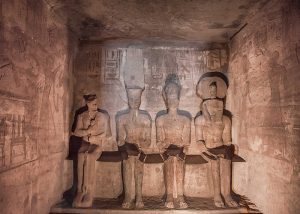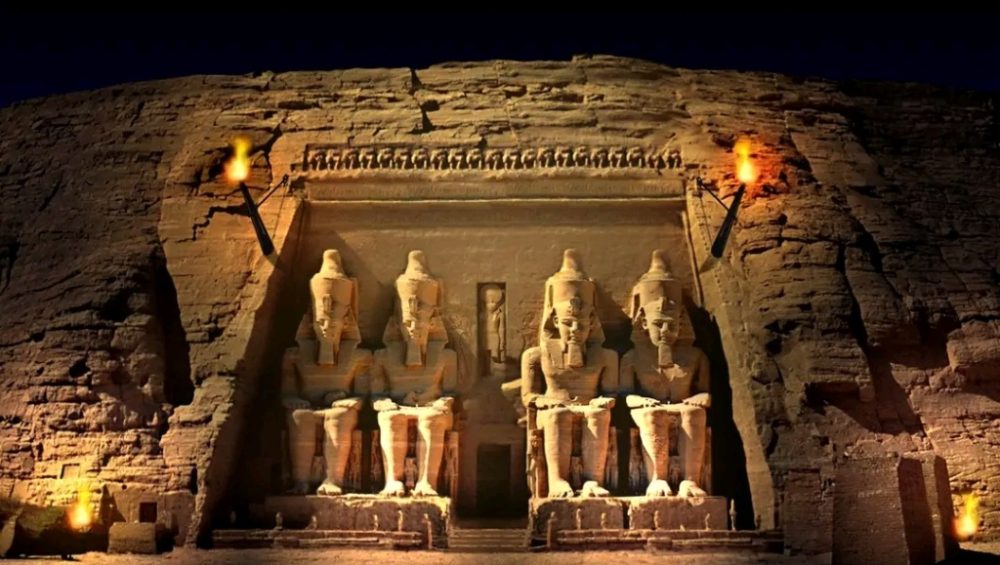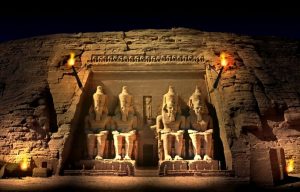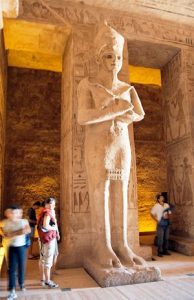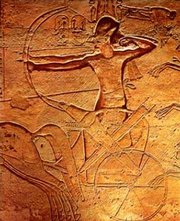Introduction
The temple is located approximately 280 kilometers south of Aswan on the west bank of the Nile River. They were built by King Ramses II around 1277 BC and completed in 1270 BC. The temple was built for the gods Amun-Ra and Ra-Hor Akhty. In this temple, Ramses II deified himself and became a god among the gods (Amun-Ra, Ra-Hor Akhty, and Ptah). The reason for choosing this location is that King Ramses II married the beautiful queen Nefertari, who was from Nubia. So he built this temple in the land of Nubia to celebrate his happy marriage to her. He built a group of temples in the land of Nubia between Abu Simbel and Kalabsha, the most important of which are his temples in Wadi es-Sebua and Gerf Hussein. King Ramses II was not content with building only one temple for himself, but for the first time in the history of Egyptian civilization, he built a temple for his beautiful wife, Queen Nefertari (the first time a temple was built for a queen who did not sit on the throne). And he was not content with that, but he made her equal to the gods. She was depicted in the temple with the size of the goddess Hathor, and her name was inscribed in a cartouche, which had never happened before for someone who had not sat on the throne. And out of his great love for her, he wrote on her temple the most beautiful love phrase: “I built the temple for the woman for whom the sun rises.” Despite his great love for her, he married others and had more than 60 concubines and more than 100 sons and daughters.
Ramses II
Ramses II was one of the greatest kings of ancient Egypt in terms of architecture and buildings. There is no place in Egypt where we cannot find a building from the era of Ramses II, especially in Abydos, Karnak, Luxor, and his temple in western Thebes, the Ramesseum, and his temples in Nubia, most importantly the temple of Abu Simbel. He ruled for a long time, 66 years, and his most important external war was against the Hittites in the land of the Tigris and Euphrates. The famous Battle of Kadesh took place between them, and King Ramses depicted its scenes in all his temples, especially on the facade of the Luxor Temple and inside the Abu Simbel Temple and on some columns in Karnak. This war ended with the signing of the oldest peace treaty in history, and King Ramses II placed a stela in front of his Abu Simbel temple on which he detailed the peace treaty, saying that after the peace between him and Hattusili, the Hittite king, a marriage took place between King Ramses II and Hattusili’s daughter, Kilu-Khiba, who came to Egypt with 300 virgin maids.
Mummy of King Ramesses II
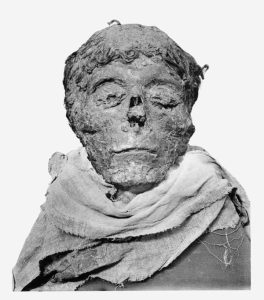 Queen Nefertari
Queen Nefertari

The Great Temple of Abu Simbel
The temple is carved into the mountain and made of sandstone. It was covered with sand, and the first to discover it was the Italian scholar Belzoni. It was discovered by the Swiss scholar Burckhardt.
The Great Temple of Abu Simbel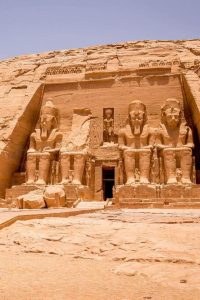
The northern statues in the Abu Simbel Temple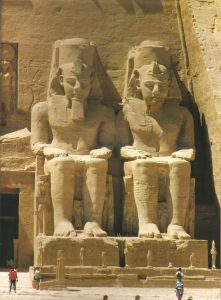
The name of the temple
There are many opinions about the reason for the name. The first opinion is that it is from an ancient Egyptian word, “Sembet,” which means “barrier.” The second opinion is that it was a place where wheat ears grew, so it was named after that. The most famous opinion is that a small child named Sembel is the one who guided the scholar Belzoni to the place, so the place was named after him.
Moving the temple
During the construction of the High Dam, the waters submerged all the Egyptian temples located between the High Dam and the borders of Egypt with Sudan. Therefore, UNESCO, with the help of the government in the sixties, launched a campaign to save the Nubian monuments, most importantly the Abu Simbel Temple due to its size. It took about 20 years to save it until 1980.
Scenes of the Dismantling and Reassembly of the Abu Simbel Temples (from the 1960s to 1980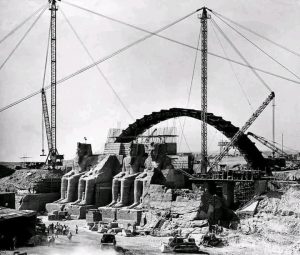
Scenes of the Dismantling and Reassembly of the Abu Simbel Temples (from the 1960s to 1980)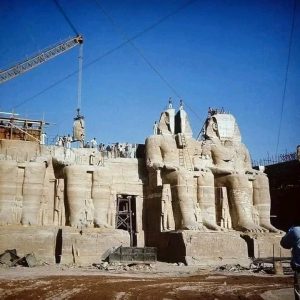
Scenes of the Dismantling and Reassembly of the Abu Simbel Temples (from the 1960s to 1980)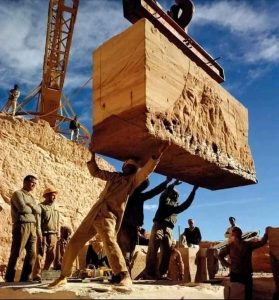
Scenes of the Dismantling and Reassembly of the Abu Simbel Temples (from the 1960s to 1980)
Scenes of the Dismantling and Reassembly of the Abu Simbel Temples (from the 1960s to 1980)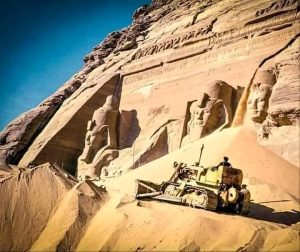 Scenes of the Dismantling and Reassembly of the Abu Simbel Temples (from the 1960s to 1980)
Scenes of the Dismantling and Reassembly of the Abu Simbel Temples (from the 1960s to 1980)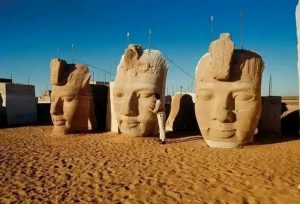
Scenes of the Dismantling and Reassembly of the Abu Simbel Temples (from the 1960s to 1980)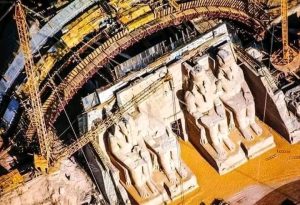
The Architectural Design of the Temple The temple consists of:
The temple’s facade
The Great hypostyle hall
The forecourt
The holy of holies
Description of the temple:
The temple facade:
Shaped like a pylon, 31 meters long, carved into the rock, and in front of it are four statues of King Ramses II. The Egyptian cornice tops the facade, and above it is a row of 22 baboons (baboons are a symbol of the god Thoth, the god of wisdom and the measure of time). The baboon was associated with cheering at the sunrise, and that’s why we always find it drawn at the base of the obelisks, cheering for the sunrise. A grand entrance is in the middle of the facade, topped by a statue of Ra-Hor Akhty with the body of a man and the head of a falcon. Above it is the solar disk, and on either side of his legs are two signs bearing the name of Ramses II. We see a view of the king on both sides of the statue of Ra-Hor Akhty offering maat (justice). In front of the facade are four statues of King Ramses II, each 22 meters tall, wearing the crown. On the statue, between the king’s legs, there are small statues of some of his family members and their names, from right to left: Khaemwaset, Khaemun, Prince of the Earth, and Khaemsaset. It is known that the third statue “Prince of the Earth” was broken in an earthquake that struck the temple only seven years after its official opening. Between the legs of the four colossal statues of Ramses II, and surrounding them, are carved statues of members of Ramses II’s royal family. From right to left, they are: his wife Queen Nefertari, their daughter Princess Meritamun, his mother Queen Mut-tuy, Princess Baketmut, Prince Ramses, Prince Amun-her-khepeshef, Princess Bentanat, an unnamed princess, and finally Princess Nebettawy. In later times, on the left leg of the third statue (the “Ruler of the Earth”), a broken inscription of historical value was recorded. This inscription tells of a campaign sent by Psamtik II, one of the kings of the 26th dynasty, in 593 BC, against Nubia. On either side of the base of the second (Beloved of Amun) and third (Ruler of the Earth) statues, a scene of the “Union of the Two Lands” is depicted. In this scene, the god Hapi, the god of the Nile and the flood, is shown binding the stems of papyrus, a symbol of the Delta, and the lotus flower, a symbol of Upper Egypt, around a hieroglyphic sign called “Sma Tawy,” which means “Unification of the Two Lands.” It is as if to say that the Nile unites Egypt with its two parts. The artist depicted the Nile god Hapi with both masculine and feminine characteristics to indicate the fertility he brings to the Egyptian soil. On the southern side of the statues, there is a scene of the marriage between Ramses II and the daughter of the Hittite king. This depicts the political marriage that resulted from the first peace treaty between the Egyptians and the Hittites, which is considered the oldest peace treaty in the world (1281 BC). In this scene, we find Ramses II seated between two gods, while the Hittite’s king and his daughter offer them allegiance. On the western wall between the southern statue and the rock, we find a scene of King Ramses wearing the crown, with a frieze of sacred cobras above it. There is also another scene of him worshipping the gods Amun-Ra and Ra-Hor Akhty.
The Shrine of Ra-Hor Akhty
On the right side, or the north of the temple, we find a shrine dedicated to Ra-Hor Akhty. Part of it is carved into the rock, and part is constructed. It was discovered under the sand by the scholar Barzanzi in 1910. The eastern wall is built in the form of two towers, and its door is decorated with a winged solar disk and cartouches of King Ramses II. Inside the shrine, there are two altars (stone sarcophagi). The southern altar has statues of four baboons with dog heads, lying down and worshiping, along with two small obelisks. The northern altar has statues of the god Khepri in the form of a scarab beetle and the god Thoth in the form of a baboon with a dog’s head. All these elements, including the statues and the baboons, are now in the Nubian Museum Garden in Aswan. The stone sarcophagus is in the Egyptian Museum in Cairo.
Statues of King Ramesses II in the facade of the temple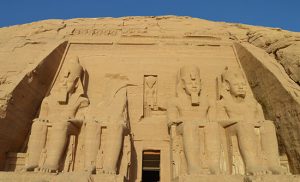
At the top of the facade of the edifice, Ramesses, on the right and left, worships the god Ra Hor Akhty
Facade of Abu Simbel Temple
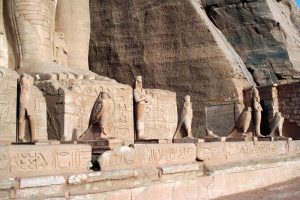
Depiction of enemies at the feet of the base of Ramses II’s statues, representing the nine bows
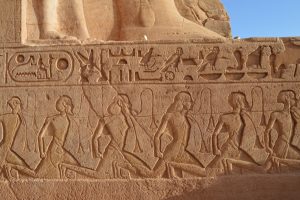
The Great Hypostyle Hall
It is a nearly square hall, approximately 16 x 17 meters. It contains eight massive square pillars carved into the rock, from which emerge colossal Osirian statues of King Ramses II, holding a scepter and a mace. The king is depicted in the northern row, on the right side of the entrance, wearing the double crown. The southern row depicts him wearing the white crown (crown of the South). On the ceiling, the bird of prey is depicted in various scenes, symbolizing the protection of the king.
One of the azure columns of King Ramses II in the grand hypostyle hall of the Abu Simbel Temple
The Southern Wall
The southern wall contains religious and war scenes from top to bottom.
Important Religious Scenes:
1- The first scene:
The king, holding a censer, stands before the gods with lion and lioness heads (gods of war).
2- The second scene:
The king stands before the god Amun-Ra, and between them are four boxes containing foundation deposits placed in the corners of the temple on its foundation day.
3- The third scene:
The king, holding a censer in one hand and throwing incense grains with the other, stands before the god Ptah, who sits with the symbols of stability and power in his hands.
4- The fourth scene:
The most important of all scenes. We find the king kneeling in the middle of the sacred tree of life, wearing the blue war crown, and the god Ra-Hor Akhty sits in front of him, blessing him. On the leaves of the tree, the name of King Ramses is written, and the leaves symbolize the number of years of the king’s reign. Behind the king stands the god Thoth and behind him his wife Seshat, who record the king’s years of reign and his most important works on papyrus.
5- The fifth scene:
We find the king holding a scepter and a censer in front of the god Amun-Ra, who sits in his shrine. Below the shrine, the cobra rises with the white crown of the South.
War Scenes on the Southern Wall:
1- The first scene:
on the left shows the king in his war chariot, aiming his arrows at a Syrian fortress. The fortress is two stories high and contains 10 soldiers, some injured and others asking the king for mercy. Below the fortress, we find a shepherd running in fear of the king’s arrows. The king is accompanied by three of his sons, each distinguished by a lock of hair on the side of his head, indicating their young age. Each of them is accompanied by a shield bearer to protect the princes.
2- The second scene
depicts the king confronting the Libyans. In one scene, he stabs one of them with his spear, and in another, he strikes a Libyan on the head with his club.
3- The third scene
shows the king riding his famous chariot, called “Victory of Thebes,” holding the sword of victory given to him by the god Amun in his right hand. In his left hand, he drives the chariot. The king’s lion runs beside his chariot. In front of the horses, there is a soldier carrying the king’s sandals, bow, and quiver of arrows. In front of him is a scene of two rows of African prisoners depicted with thick lips, curly hair, and wearing leopard skins. Each of them is tied with their arms bound behind their backs, and each row of prisoners is tied by a rope around their necks to prevent them from escaping.
The Eastern Wall
The eastern wall of this hall is divided into two parts, north and south. On the northern part, there are scenes of King Ramses II holding the heads of ten Asian prisoners in front of the god Ra-Hor Akhty, who gives him the curved sword of victory (a symbol of Egyptian kingship). Below this scene are eight of Ramses II’s sons, each holding a fan in their hands. On the southern part of the eastern wall, there are scenes of King Ramses II holding Nubian prisoners in front of the god Amun-Ra. Below the scene are nine daughters of Ramses II, each holding a rattle in their hands, celebrating the great victory. On the western wall, we see a scene of counting the prisoners in the Battle of Kadesh. On the northern wall, we find the Egyptian camp and an important scene showing the flaying of the spies as punishment.
King Ramesses II inside his war chariot during the Battle of Kadesh
The Stela of Ptah
Located between the third and fourth columns from the southern side, this stela was dedicated to the god Ptah, the god of craftsmanship in ancient Egypt. The stela is divided into an upper and lower section. The upper section depicts a scene of Ramses II holding the heads of three captives in front of the god Ptah, who himself holds six captives. The lower half of the stela contains historically significant texts. In these texts, the king declares himself to be the son of the god Ptah. He also explains the reason for constructing the temple, stating that he built it to ensure his eternal existence on Earth, similar to the enduring pillars of the sky. The king further mentions on the stela the story of the visit of Hattusili and his daughter, Kilu-Khiba, to Egypt. Ramses II married Kilu-Khiba.
King Ramesses II worships the god Ptah and makes sacrifices to him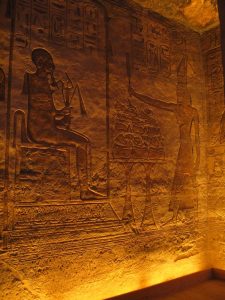
The small Hypostyle Hall
Consists of four-square pillars adorned with statues of the king in the Osirian form. A distinctive feature of this hall is that the reliefs have retained their original colors.
The hall’s main scenes
All scenes are all religious, depicting the king offering incense and offerings to various gods.
Southern Wall:
Here, the king offers incense to the god Amun-Ra.
Northern Wall:
In this section, the king offers incense to the god Ra-Hor Akhty. One of the most magnificent scenes on the southern wall depicts King Ramses II holding a censer in front of an offering table. The king is offering incense to the divine bark of Amun, which is carried by twenty-one men. The front and rear of the bark are shaped like rams’ heads. Behind the bark, Queen Nefertari stands holding a sistrum (a musical instrument). In this scene, the queen assumes the role of the goddess Hathor, goddess of music, and she wears a wig. Notably, both the king and queen are barefoot as they stand within the sacred enclosure of the god. On the northern wall, a similar scene is depicted, but the queen wears the crown of Hathor instead of a wig. The offerings are made to the god Ra-Hor Akhty, and the front and rear of the divine bark are shaped like a falcon, symbolizing Horus. The king offers flowers to the Theban triad: Amun, Mut, and Khonsu. Interestingly, the king depicts himself as the son of God and his wife, instead of their son (Khonsu).
The small Hypostyle Hall
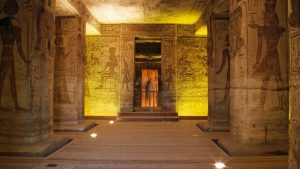
The Hall of Illumination
After the small Hypostyle Hall, we enter a hall called the Hall of Illumination. This hall has three entrances. Two of these entrances lead to small, decorated side chambers. The central entrance leads to the sanctuary.
The Side Chambers
There are a total of ten side chambers (including the two in the Hypostyle Hall). These chambers were: dedicated to the daily rituals of the god, such as storing the god’s clothing, food, and drink. They also stored offerings and documents related to the temple’s property, including lands and slaves. Some chambers had carved stone benches for the priests to sit on or to place offerings upon. One chamber was specifically designated for the king to change his clothes and crowns (this chamber is located in the Hypostyle Hall).
Important Scenes in the Hall
The hall primarily depicts scenes of the king offering various offerings to different gods. For example: He offers wine to the god Min-Amun, the god of fertility, milk to the god Amun, bread to the god Atum, and flowers to the god Ptah. He also offers a small statue of Maat (the symbol of truth and justice) to the god Thoth.
Columns in which the king appears with various gods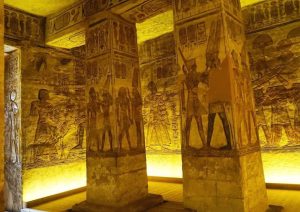
The Holy of Holie
the most important part of the temple, a sacred place accessible only to the king or the high priest acting on his behalf during daily rituals. In the center of the holy of holies, there was a stone base upon which the divine bark was placed. Two barks were situated on this base: one for the god Amun-Ra, with the head of a ram at both the front and rear, located on the southern side; and the other for the god Ra-Hor-Akhty, with the head of a falcon at both the front and rear, located on the northern side. Consequently, the king offered incense on both the southern and northern sides to these divine barks.
The Fame of Abu Simbel Temple
On the western wall, there are four colossal statues representing the gods Ra-Hor-Akhty, Ramses II, Amun-Ra, and Ptah (who has lost his head). Twice a year, on October 22 and February 22, the rising sun illuminates the faces of all these statues except for the statue of Ptah (because he is the god of the dead, and the sun symbolizes life). This is an extraordinary astronomical phenomenon that remains unexplained to this day. Some interpret these two days as the birthday and coronation day of King Ramses II. Others interpret them as symbols of the seasons of planting and harvesting. What is astonishing is that even after the temple was relocated, the sun continues to rise on these same days.
The four statues within the Holy of Holies represent the gods Ra-Horakhty, Ramses II, Amun-Ra, and Ptah
